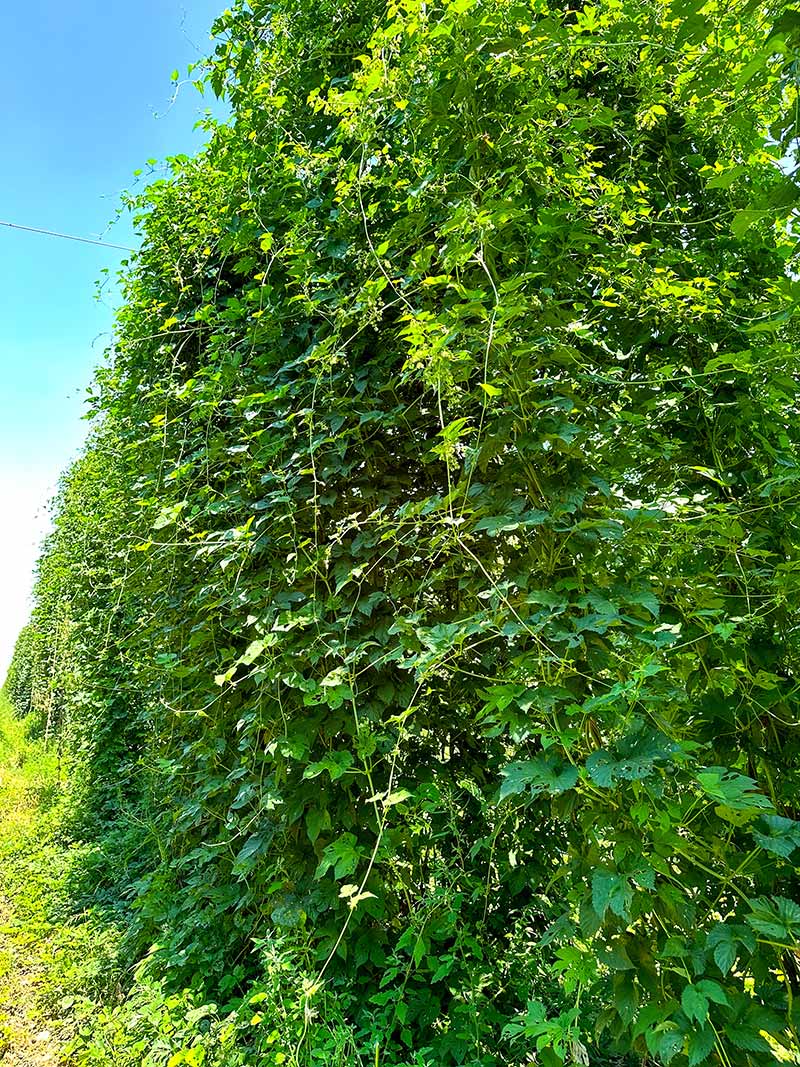
Before a hop becomes mainstream among brewers across the globe, it goes through an experimental phase. It’s part of the cycle to ensure the best make it to a commercial market. For example, Centennial went through the U.S. Department of Agriculture’s breeding program at Washington State University; the wildly popular Mosaic went through the Hop Breeding Company as HBC 369; Segal Ranch’s new intriguing Anchovy hop started as Experimental 24B-05; and the Hop Breeding Company still hasn’t entirely branded HBC 586 despite its fame in craft beer circles. Similarly, family-owned hop ranch CLS Farms in Washington has bred its own experimental hop, CLS-X14, which it hopes will join the aforementioned ones, included in great craft beers nationwide.
We chatted with CLS Farms and Pinthouse Brewing to learn more about CLS-X14’s ancestry and analytics, how to best use the experimental hop, which style suits it best, and whether it can shine successfully on its own.
(Above photography courtesy of CLS Farms)
Affordable, Industry-Leading Brewery Software
What Are the Ancestry and Analytics of CLS-X14 Hops?

Graphic courtesy of CLS Farms
CLS Farms Brand and Customer Relationships Manager Claire Desmarais says the company started breeding CLS-X14 a few years ago.
“We saw a crop year boom in high-aroma and high-impact hops,” Desmarais says, noting that CLS Farms is home to similar hops like El Dorado and Zappa. “We saw a need in the market for lighter varieties and set out to bring an American Noble variety.”
According to recent trends, light lagers have been gaining traction for the last few years, presenting a need for a lighter hop.
In 2021, Desmarais says they started expanding this experimental hop, a cross between Cluster and a wild Neomexicanus hop.
“And we wanted to add to our portfolio a hop that could withstand climate change,” Desmarais says. “CLS-X14 grows a lot, has good disease resistance, and can be picked later in the season.”
Desmarais says they are still dialing in the pick dates of CLS-X14 to better understand its disease and drought tolerance.
After testing in 2021, Desmarais says they had enough volume to disperse CLS-X14 to brewers. In 2023, CLS Farms repeated the volume of 2022, and this year, the farm produced the same acreage but took a slightly different approach.
“It is dispersed in different areas to see how it handles [slightly different climates],” Desmarais says.
CLS-X14 has seven to nine percent alpha acids and three to four percent beta acids. The total oils of CLS-X14 are 1.5mL, mainly composed of Myrcene oil (37.8%), then Humulene (19.9%), Caryophyllene (8.3%), Linalool (0.9%), and other oils taking up the other 32.5%.
“It’s interesting and great for the styles it’s trying to fit into,” Desmarais says. “A little higher than a German Noble hop, but not too high.”
What Characteristics Shine in CLS-X14 Hops?

Photography courtesy of Pinthouse Brewing
CLS Farms describes the CLS-X14 experimental hop with notes of lemongrass, lime zest, floral, and stone fruit.
“Overall, the floral and citrus notes are most predominant,” Desmarais says. “And those come out in the beer as well.”
Pinthouse Co-Founder and Vice President of Brewery Operations and Distribution Joe Mohrfeld says experimental hops give him a nice mix of character.
“It’s a delicate blend of traditional Noble character,” he says, “and soft bright citrus notes.”
CLS Farms Technical Advisor and Brewmaster Alexandra Nowell echoes Mohrfeld’s sentiment, saying she gets “delicate yet expressive floral and citrus aromas.”
“I always pick up lemongrass and lime zest in the hop rub, with some jasmine and a tarragon-like herbaceous finish,” Nowell says. “Thankfully, they also come through in the beer, because they make for a beautiful hop profile.”
Is CLS-X14 Dominant on Its Own or as a Complementary Hop?

Photography courtesy of CLS Farms
Desmarais says CLS Farms has worked with breweries like Pinthouse that have tried single-hop and multi-hop CLS-X14 beers. Whether the hop is best on its own or paired depends.
“It can hold its own by itself, more specifically in lagers or pilsners,” Desmarais says. “I think it does better by itself in lighter beers. If you pair it, you need to ratio it out to not overshine CLS-X14.”
Desmarais adds, “Pairing with Comet is a great combo. Or Cashmere. It pairs really nicely.”
Mohrfeld thinks it can go either way as well.
“I believe it can be used on its own. However, we found that it played very well with other established hops and brought more depth of character to the beer,” Mohrfeld says. “Depending on the style, it can be a solo player, but in most applications for a heavier hopped IPA, it will work well as a complementary hop to add depth of character.”
Nowell has a similar viewpoint as Desmarais.
“It could make an excellent standalone hop in traditional lager applications,” Nowell says. “But it would definitely benefit from some help from other hop friends in modern lager or IPA.”
When Should You Use CLS-X14 Hops?

Photography courtesy of CLS Farms
According to CLS Farms, the CLS-X14 experimental hop is best for hot side and whirlpool additions. Nowell says she’s seen it work well on the hot side and cold side.
“Personally, I would lean into its usage as a kettle hop because that’s where I’m traditionally looking for a Noble-type hop variety to shine,” Nowell says.
Mohrfeld says Pinthouse has found the best way to use CLS-X14.
“We used this hop in the whirlpool and dry hop,” he says. “It presents as a solid dual-purpose hop that can be used throughout the process.”
Desmarais says they’ve seen quite a few brewers using it as an early whirlpool addition and a little dry hop, but not too much.
“Other people use it throughout,” she says. “Early addition whirlpool is where it’s best suited.”
Desmarais adds that they’ve spent a lot of time seeking feedback on aroma and are now getting evaluations on the application, too.
“As a grower or hop owner, you may have an idea, but the brewer is the ultimate tester for usage,” Desmarais says. “We’ve learned a lot in the last six to eight months on what the brewers need and how they use it.”
She adds, “We’re in the next stage in understanding where it fits.”
Desmarais notes that Nowell has advocated for CLS-X14 as an alternative to German Noble hops as the industry continues to face climate challenges.
Which Style of Beer Works Best for CLS-X14 Hops?
“I would say a really nice crushable lager,” Desmarais says. “It seems to be the cleanest and most expressive style for this hop.”
Desmarais says it can be used in blonde ale and pale ale, but it could get washed away.
“So I think to use it in a single-hop lager is best,” she says.
Mohrfeld notes it can work in multiple styles if done right.
“Lighter styles as a solo hop,” he says. “And a complementary hop in a more heavily hopped IPA or pale ale.”
Nowell sees it working well in different variations of lighter beers.
“Traditional lagers of all types, absolutely,” Nowell says. “CLS-X14 also plays well in the more modern iterations of lager, but it will end up in a backseat role when matched with the high impact American varieties often used in those styles.”



